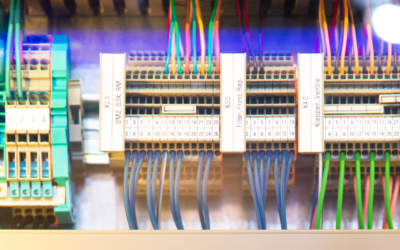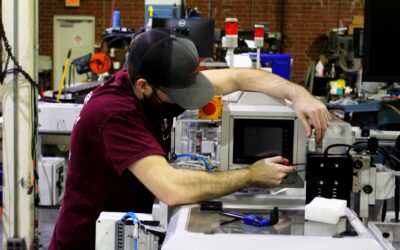Article originally appeared on Forbes.com by Steve Banker, Contributor to Forbes.com
I visited Micron Products to hear about their installation of a robot, really two integrated robots, to automate the process of picking and placing small plastic fasteners into shipping crates. I was interested in learning more about robotic gripper systems used in picking applications and seeing the technology in action.
Micron Products produces billions of parts a year. This contract manufacturer – headquartered in Fitchburg, Massachusetts in the U.S. – specializes in plastic injection molding for the medical device, aerospace, defense and life sciences markets. In this industry you win business by offering customers low unit prices. “That requires automation and inventiveness,” Salvatore Emma said. Mr. Emma is the President and CEO at Micron Products.
For a company that manufacturers billions of parts, their facility was surprisingly small, roughly 120,000 square feet. The company employs just over 100 people across three shifts.
Prior to the implementation of the robots, the injection molding machine pushed out pieces at high speed onto a conveyor line, and six workers would scoop up a whole line of pieces and put them in boxes for shipping. The pieces produced are one of the components used in constructing automotive seats. The fasteners go inside the seats and help hold the internal wiring of the seat together.
“This was the worst job in the plant,” Drew Santin, the Vice President of Business Development said. Workers would try and get out of working in this cell. “They had to work at a furious pace.” Even stopping to itch their nose could make it difficult to keep up.
But this project was driven by economics. “We had quoted a certain price per piece.” Mr. Emma explained. “We had underestimated the cost. We needed automation.”
Two years ago, in the second quarter of 2016, Micron asked Advanced Automation, and a couple of other automation houses, to come in and see if they had a solution. Advanced Automation, out of Portsmouth New Hampshire, specializes in the implementation of ABB’s line of robots. Micron chose to work with Advanced Automation because they had a solution with good ROI, and that they would be able to automate the production cell faster than their competitors. Advanced Automation quoted eight weeks to get the robot, implement it, and one week to debug the system. That is a very, very fast turnaround time for this industry. They met that lead time promise. The existing manual process continued to be used right up until implementation. The production cell only had to shut down for a few days during the installation.
Advanced Automation decided to use one of the robots in ABB’s FlexPicker line, a form of what is known as spider robots. This robot arrived from the factory in Michigan almost fully assembled.
They augmented this robot with a robotic gripper system from Soft Robotics that were placed at the end of the FlexPicker arms. They needed the Soft Robotics solution because the plastic pieces, which come out of the mold at a temperature of 90 to 100 degrees and still somewhat soft, would have been crushed by a traditional spider robot. They also needed a solution that would pick and put objects at high speed. While the spider robots are becoming a commodity, gripper robotic systems are not.
Micron looked at suction for the picking, but the pieces needed to fall into the shipping box with a high degree of precision – not being dropped too soon or too late and landing on the floor. Suction solutions were not able to accomplish that.
Soft Robotics is a young company headquartered in Cambridge, Massachusetts in the U.S. The company has received 25 million dollars in venture financing, with one of their investors being ABB. In contrast to other robotic picking solutions that try and solve this problem with complex machine learning algorithms that work to determine exactly how much pressure to apply and how to precisely orient the picking mechanism, Soft Robotics secret sauce is based more on material science. The gripper is like a soft glove that is pneumatically filled with air and softly envelops the object picked. This methodology greatly simplifies the math that is required.
The control system involves control software for the spider robot arms, control software for the gripper system, a vision system integrated to both solutions, and a sensor that measure the speed of the conveyor and the precise position of the parts on the conveyor.
The ROI was dramatic. Six people could move to other tasks. Their annual salary was roughly one quarter of a million dollars. While occasionally labor is needed on the pack line, it is ten percent of what it used to be. Further, the cell can now operate at a faster speed, it does not need to slow down to accommodate human labor. I must say when I viewed the operation, I was blown away by the speed at which the robot picked and placed parts (see a video here).
Meanwhile, the robotic cell cost 140,000 dollars. For Micron, this represented a conservatively calculated payback period of eight months. And the financial calculation did not include soft benefits like employee satisfaction, the ability to redeploy qualified workers (who are increasingly difficult to hire), and almost no pack defects (much better than Six Sigma accuracy).
Chad Zrate, a director of one product line and an engineering manager at Micron, said the “results were good initially and have continued to improve. It is so much better than it was.”
Micron is a lean manufacturer committed to continuous improvement. Taylor Breau, a manufacturing engineer at Micron, explained that the latest project aimed at improving the throughput of this cell involved taking slow motion pictures of the robotic arm in action, which gave them insights into how the system could be tweaked.
I came away from this tour with a couple of impressions. First, it is possible for small contract manufacturers based in the U.S. to be globally competitive, particularly if they have built strong in-house automation expertise and work with knowledgeable automation partners. Secondly, the ROI of this robotic project was excellent. Any payback of less than a year for automation projects is excellent! There appears to be a lot of low hanging fruit in robotic pick/pack automation.









